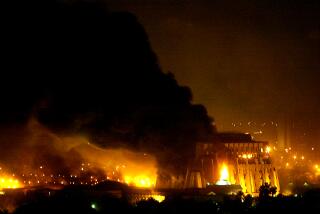Nothing Like Friends in the Right Places : Panama: The invasion was a success for several reasons, not the least being the presence of U.S. forces already in the country.
ALEXANDRIA, VA. — Whatever its international political ramifications, the U.S. invasion of Panama--code-named Operation Just Cause--constitutes the most successful American combat undertaking since Gen. Douglas MacArthur’s surprise 1950 descent upon the Korean coast at Inchon.
The Pentagon, especially the Army, deserves great credit for engineering a military victory that stands in sharp contrast to the debacle of Vietnam, the bungled 1980 Iranian hostage rescue mission, the fatal 1982-84 deployment in Lebanon of U.S. Marine Corps “peace-keeping” forces and the highly qualified 1983 “victory” of U.S. forces over isolated and poorly armed Cubans in Grenada.
Just Cause, like the assault on Grenada, proves that nothing works like the invasion of a friendly country. In just two weeks, U.S. forces erased threats to the Panama Canal and to American citizens in Panama, replaced a hated despotism with hope of genuine democracy and brought a manacled drug-thug before the bar of American justice. And all this was accomplished at a cost of 23 American servicemen dead, or less than one-tenth the number of Marines who died in Lebanon at the hand of a terrorist.
Some have ascribed the operation’s success to the Defense Reorganization Act of 1986. Legislated by a Congress frustrated over past U.S. military performance, the act sought to simplify lines of command authority and strengthened the power of U.S. regional commanders and the chairman of the Joint Chiefs of Staff at the expense of the service chiefs.
The view that the act paved the way for victory in Panama is, however, suspect. For one thing, it assumes that military effectiveness can be ordered up by congressional fiat. Though some measure of defense reorganization was long overdue by 1986, it is far from self-evident that Just Cause would have come a cropper without it.
Much more important to the invasion’s success was the fact that the U.S. military in Panama enjoyed a singular combination of advantageous circumstances--a combination absent in Iran, Lebanon and Grenada. The most obvious was the substantial presence before the invasion of U.S. ground combat forces, a growing rarity for the United States in the Third World these days. Building on forces already in place is a far easier task than starting from scratch, especially from another hemisphere, as was the case in Iran and Lebanon.
Also impressive were the quality and thoroughness of U.S. preparation. The Pentagon not only had plenty of time to plan Just Cause (the Grenada operation was thrown together in a few days and suffered accordingly), but also came up with a scheme of operations that for once took stock of some lessons learned from past screw-ups. For example, Just Cause applied overwhelming force simultaneously against critical enemy positions, quickly paralyzing enemy resistance.
Other advantages were also present. Conditions were ideal for large-scale operations, a prominent feature of Just Cause. Air-dropping lightly armed and foot-mobile troops behind enemy lines is a risky business (recall the Allied and German airborne disasters of World War II). Success requires, among other things, a combination of good weather, scant enemy resistance in the drop zones and, most of all, the proximity of friendly ground forces able to relieve the parachutists before the latter run out of ammunition or are ground down by enemy forces. All these conditions were present in Panama.
But perhaps the most important, if little mentioned, ingredient of Just Cause’s success was that it was planned and executed largely by a single service. Since 1945, major U.S. military actions have largely been joint operations involving most or all of the services. One reason is each service’s desire to get a piece of the action, even in the absence of legitimate operational requirements. However, the price can be quite stiff (as in the case of selecting ill-qualified Marine pilots to fly the helicopter force of the Iranian rescue mission).
Just Cause was mainly an Army show because the U.S. Southern Command headquartered in Panama is mainly an Army outfit, and because the military challenge demanded only a supporting role from the Air Force and virtually nothing from the Navy and Marine Corps. By virtue of its domination by one service, Just Cause reduced the potential for problems arising from gratuitous jointness.
Like any other combat venture, Just Cause had its glitches. Overall, however, it must be counted as a major success.
Yet the question remains whether it can be replicated elsewhere in the Third World, an area drawing the increasing attention of all the armed services in an era of a receding Soviet military threat to Western Europe and collapsing Communist political authority in Eastern Europe.
Where else in the Third World, outside of such eroding Cold War deployments as remain in South Korea and the Philippines, could the United States in a crisis look to build upon a sizable ground combat presence already in place?
Certainly not the Persian Gulf, where U.S. military intervention in 1987-88 was restricted almost exclusively to sea-based forces. Certainly not in North Africa or mainland Southeast Asia, where once-plentiful U.S. military bases have vanished. And not even in Panama after 1999, when the last U.S. soldier is treaty-bound to depart the country.
Just Cause was indeed a victory, but it was a victory fathered by the Pentagon’s exceptional military position in Panama.
More to Read
Sign up for Essential California
The most important California stories and recommendations in your inbox every morning.
You may occasionally receive promotional content from the Los Angeles Times.










